The Improvement of Watershed Algorithm Accuracy for Image Segmentation Handwritten Numbered Musical Notation
(1)
(*) Corresponding Author
Abstract
Full Text:
PDFReferences
S. Wijayanti, Seni Budaya (Musik) Kelas X SMA Negeri 1 Pati, Seni Budaya Kelas X SMA, p. 2006, (2006).
Murinto and A. Harjoko, Segmentasi citra menggunakan watershed dan itensitas filtering sebagai pre processing, Seminar Nasional Informatika, 4347, Mei 2009.
D. Rahmawati, A. Harjoko, and R. Sumiharto, Purwarupa sistem tracking sungai menggunakan unmanned aerial vehicle, Indonesian Journal of Electronics and Instrumentation Systems, 3 (2), 157164, 2013.
A. R. Himamunanto and A. R. Widiarti, Javanese character image segmentation of document image of Hamong Tani, Digital Heritage International Congress, 1, 641644, 2013.
A. R. Widiarti, A. Harjoko, S. Hartati, and Marsono, Implementasi model segmentasi manuskrip beraksara Jawa pada manuskrip beraksara Batak, Proceeding Seminar Nasional Inovasi dan Teknologi Informasi, 8184, Oktober 2014.
T. Shreekanth and V. Udayashankara, A two stage braille character segmentation approach for embossed double sided Hindi devanagari braille documents, International Conference on Contemporary Computing and Informatics, 533538, November 2014.
S. Biswas and A. K. Das, Text segmentation from scanned land map images using radon transform based projection profile, Proceedings of the International Conference of Soft Computing and Pattern Recognition (SoCPaR), 413418, 2011.
D. Min, Research on numbered musical notation recognition and performance in a intelligent system, Institute of Information and Engineering Hunan University of Science and Engineering, 25, 2011.
R. C. Gonzalez and R. E. Woods, Digital Image Processing: 2nd, Publishing Company, USA, 2002.
Y. Zhang and X. Cheng, Medical image segmentation based on watershed and graph theory, no. 1, 14191422, 2010.
K. Pinaryanto and A. R. Widiarti, Implementasi segmentasi citra dokumen teks sastra Jawa menggunakan algoritma watershed, Undergraduate thesis, Universitas Sanata Dharma, 2009.
DOI: https://doi.org/10.24071/ijasst.v1i1.1875
Refbacks
- There are currently no refbacks.
Publisher : Faculty of Science and Technology
Society/Institution : Sanata Dharma University

This work is licensed under a Creative Commons Attribution 4.0 International License.











